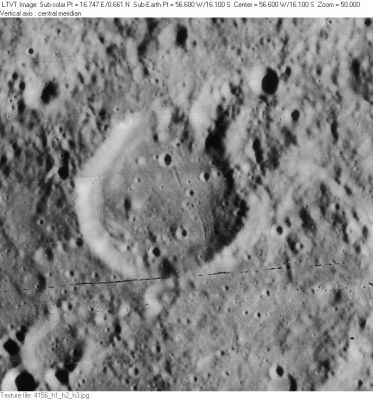Difference between revisions of "Fontana"
| Line 6: | Line 6: | ||
|} | |} | ||
<div id="toc"> | <div id="toc"> | ||
| − | [http://www.lpod.org/coppermine/albums/userpics/Fontana_LO-IV-156H_LTVT.JPG [[Image: | + | [http://www.lpod.org/coppermine/albums/userpics/Fontana_LO-IV-156H_LTVT.JPG [[Image:Normal_Fontana_LO-IV-156H_LTVT.JPG|external image normal_Fontana_LO-IV-156H_LTVT.JPG]]]<br /> ''[http://lpod.org/coppermine/displayimage.php?pos=-2009 LO-IV-156H]''<br /> <br /> |
==Images== | ==Images== | ||
[http://www.lpod.org/coppermine/thumbnails.php?album=search&type=full&search=Fontana LPOD Photo Gallery] [http://www.lpi.usra.edu/resources/lunar_orbiter/bin/srch_nam.shtml?Fontana%7C0 Lunar Orbiter Images]<br /> <br /> | [http://www.lpod.org/coppermine/thumbnails.php?album=search&type=full&search=Fontana LPOD Photo Gallery] [http://www.lpi.usra.edu/resources/lunar_orbiter/bin/srch_nam.shtml?Fontana%7C0 Lunar Orbiter Images]<br /> <br /> | ||
| Line 14: | Line 14: | ||
<br /> | <br /> | ||
===Elger=== | ===Elger=== | ||
| − | ''([[IAU% | + | ''([[IAU%20directions|IAU Directions]])'' FONTANA.--A noteworthy ring-plain, about 20 miles in diameter, W.N.W. of [[Zupus|Zupus]], with a bright border, exhibiting a narrow gap on the S. and two large contiguous craters on the N.E. The faint central mountain stands on a dusky interior. On the N. is a large peculiar depressed plain with a gently sloping wall, within which are three short rill-like valleys and a crater.<br /> <br /> |
===Wikipedia=== | ===Wikipedia=== | ||
[http://en.wikipedia.org/wiki/Fontana_%28lunar_crater%29 Fontana]<br /> <br /> | [http://en.wikipedia.org/wiki/Fontana_%28lunar_crater%29 Fontana]<br /> <br /> | ||
===Additional Information=== | ===Additional Information=== | ||
* IAU page: [http://planetarynames.wr.usgs.gov/Feature/1990 Fontana] | * IAU page: [http://planetarynames.wr.usgs.gov/Feature/1990 Fontana] | ||
| − | * Depth data from [[Kurt%20Fisher% | + | * Depth data from [[Kurt%20Fisher%20Crater%20Depths|Kurt Fisher database]] |
** Westfall, 2000: 1.13 km | ** Westfall, 2000: 1.13 km | ||
<br /> | <br /> | ||
Latest revision as of 01:49, 16 April 2018
Contents
Fontana
|
Lat: 16.07°S, Long: 56.76°W, Diam: 31.47 km, Depth: 1.13 km, Rükl: 51 |
Images
LPOD Photo Gallery Lunar Orbiter Images
Maps
(LAC zone 92B1) LAC map Geologic map
Description
Elger
(IAU Directions) FONTANA.--A noteworthy ring-plain, about 20 miles in diameter, W.N.W. of Zupus, with a bright border, exhibiting a narrow gap on the S. and two large contiguous craters on the N.E. The faint central mountain stands on a dusky interior. On the N. is a large peculiar depressed plain with a gently sloping wall, within which are three short rill-like valleys and a crater.
Wikipedia
Additional Information
- IAU page: Fontana
- Depth data from Kurt Fisher database
- Westfall, 2000: 1.13 km
Nomenclature
- Named for Francesco Fontana (c. 1585-1646), an Italian astronomer who built telescopes which he felt rivaled or exceed those of Galileo. Fontana, a lawyer by trade, published a number of maps of the Moon, including at least 28 illustrations of different phases which Whitaker refers (p. 47 and 49, perhaps unjustly) as "wildly imaginative (and inaccurate!)". Some of his images reportedly appeared in books published by others. - Jim Mosher
- The entire text of Fontana's Novae coelestium is available in the ETH's e-rara and in the IMSS Digital Library.
- Start of Lunar section on e-rara.
- A few pages, including Fontana's celebrated full disk map can be found at the University of Oklahoma.
- More samples.
- The entire text of Fontana's Novae coelestium is available in the ETH's e-rara and in the IMSS Digital Library.
LPOD Articles
Bibliography
- Fontana, Francisco. 1646. Novae coelestium terrestriumque rerum observationes. Naepoli: Gaffarus.
Fontana in the Sourcebook Project (William R. Corliss)
- In Mysterious Universe, a handbook of astronomical anomalies (1979) :
- Page 141: The Problematical Satellite of Venus (Observatory, 1884).
- Page 142: The Supposed Satellite of Venus (Observatory, 1887).
Note: these two articles are from the days when the so-called moon of Venus ("Neith") was a hot topic in the astronomical world.
Named Featues -- Prev: Rimae Focas -- Next: Fontenelle
